
- Source: ArtNet News
- Author: Taylor Dafoe
- Date: September 8, 2021
- Format: Digital
Fifteen Years Ago, Keltie Ferris Was Peter Halley’s Student. The Artists, Now Friends, Sat Down to Talk Shop as They Debut New Work
The painters are showing their latest abstract paintings at the Independent art fair this week.
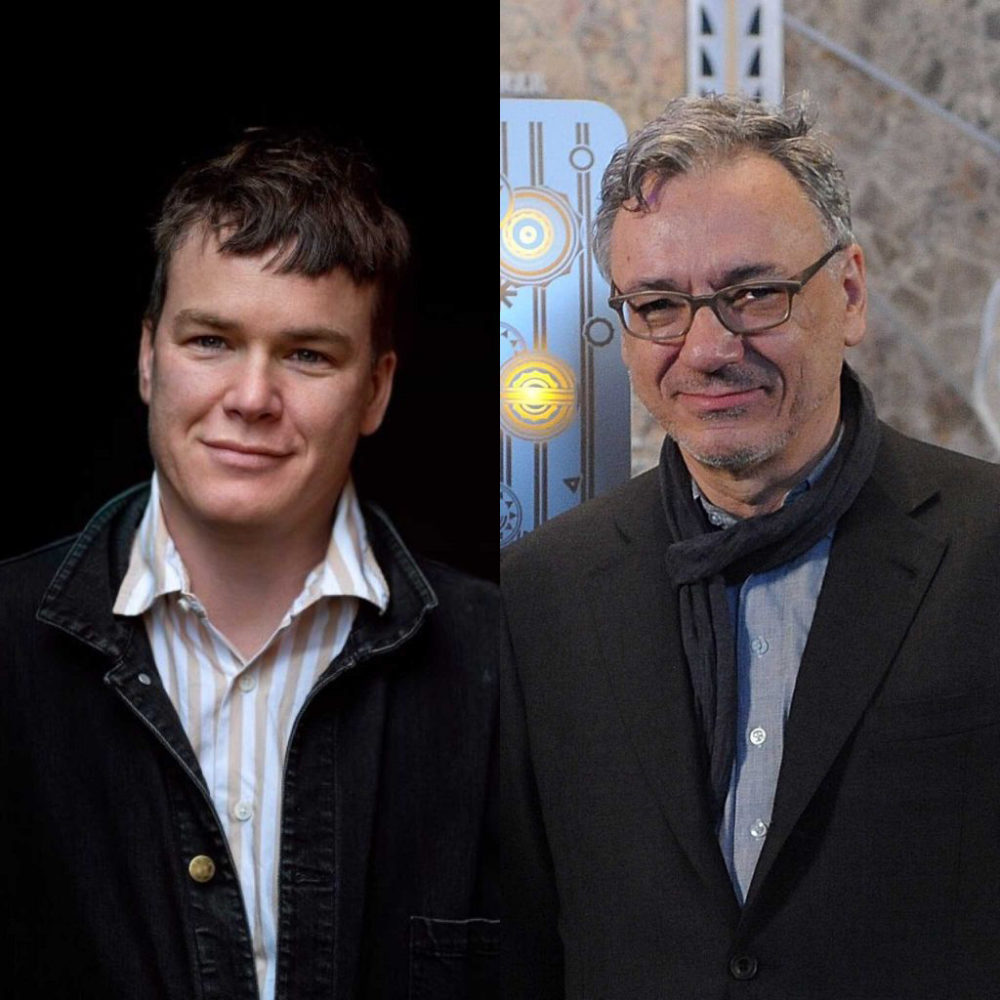
Left: Keltie Ferris. Courtesy of Morán Morán. Photo: Matthew Spiegelman. Right: Peter Halley. Photo: Brad Barket/Getty Images.
Peter Halley and Keltie Ferris first met sometime in the mid-2000s, at the height of the abstract painting revival. Halley, a pioneering Neo-Conceptualist renowned for his disciplined grids, was head of painting and printmaking at the Yale School of Art; Ferris, a graduate student with a knack for wielding fluid materials like spray paint. Nevertheless, their work had a lot in common: a love of color, especially jangly fluorescents; an embrace of digital influences; and a desire to release painting from both its figurative and abstract forebears.
Through the course of the teaching relationship, each found a respect for the other’s practice, and the conversation has continued—even if the two artists don’t actually talk as much as they once did. To pit their paintings against each other today is like seeing estranged cousins reunite: time has changed them, but you can’t deny the shared DNA.
You’ll get to do the chance to do just that this week at Independent New York, where both artists are presenting new paintings—Ferris with his Los Angeles gallery, Morán Morán, and Halley with The Ranch, Max Levai’s new gallery located on Andy Warhol’s old farm in Montauk.
Ahead of the fair, the two got together to catch up, with Artnet News in tow to record the results. What followed was a wide-ranging conversation about working methods, color “friendships,” and setting up problems just to fix them.
This interview has been edited and condensed for clarity. The audio version of Halley and Ferris’s conversation is published on The Art Angle, Artnet News’s weekly podcast.
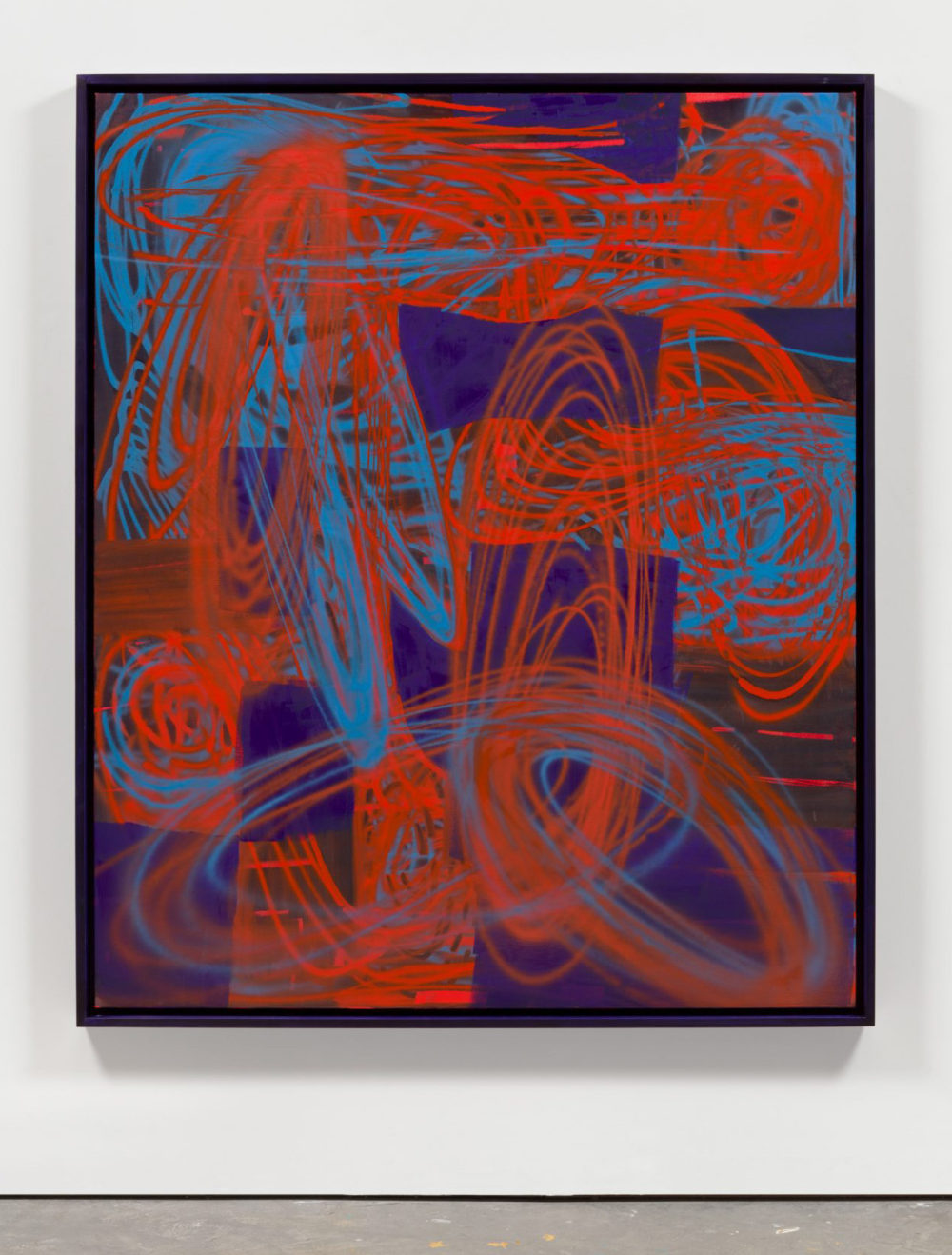
Keltie Ferris, Ultra Blue You (2021). Courtesy of the artist and Morán Morán.
Keltie Ferris: Hi Peter.
Peter Halley: Hi Keltie. Good to talk to you, as always. Yesterday, I was trying to think back—even from the time when you were a grad student, I felt an affinity with your work because of your use of contemporary materials—spray paint, et cetera—as well as the digital-aged energy of your work.
KF: A sense of paintings looking forward. Of course, all paintings look backward, and they have to because they’re paintings, but I think a thing we have in common is that we’re trying to look forward in time to the future. We’re both somewhat future-obsessed.
PH: Looking back at your work for the last 15 years, that’s obviously in the work. But were you like that way back when, as a very young artist?
KF: I don’t know if I was then, actually. In fact, I came into school with the problem of being art history-dependent. I always had an art history book open while working, really. Getting away from that was probably the influence of you and the school, learning to think more about the present tense and the idea that paintings have a life in the future—that you should address what you thought the medium was going to become or what you hoped it would become, as well as what it had been. That takes you into the realm of science fiction, because one doesn’t know what’s going to happen. It has to do with an interest in technology, too, which [is what] the sprayed mark represents for me.
PH: My paintings are not very athletic. I do these studies sitting at a table, and then they’re put together in a very mechanical way. That’s another thing that’s always struck me about your work: you have a really athletic relationship to your paintings and drawings.
KF: That is one way in which we were very different! [Laughs] In the early 2000s, I felt—whether this is true or not—that it was near impossible to make a gestural painting that didn’t feel extremely indebted to the 1950s and thus have an antiquated, patriarchal throwback feel in a really negative way. I was an athletic person and a person prone to the gesture; I was looking for ways to do that that didn’t feel outdated. That’s one reason I started looking toward the future. It was a lot of experimentation with mark-making and materials. The spray paint mark was the one I landed on that I really stuck with. I guess the gesture is not really your focus, to say the least.
PH: Yeah, it’s a little bit contradictory, but I consider my paintings idealist insofar as I want their content to come solely out of my head, not from the hand or body. They are tactile, but there’s no personality in how they’re made. It’s philosophically important, I think.
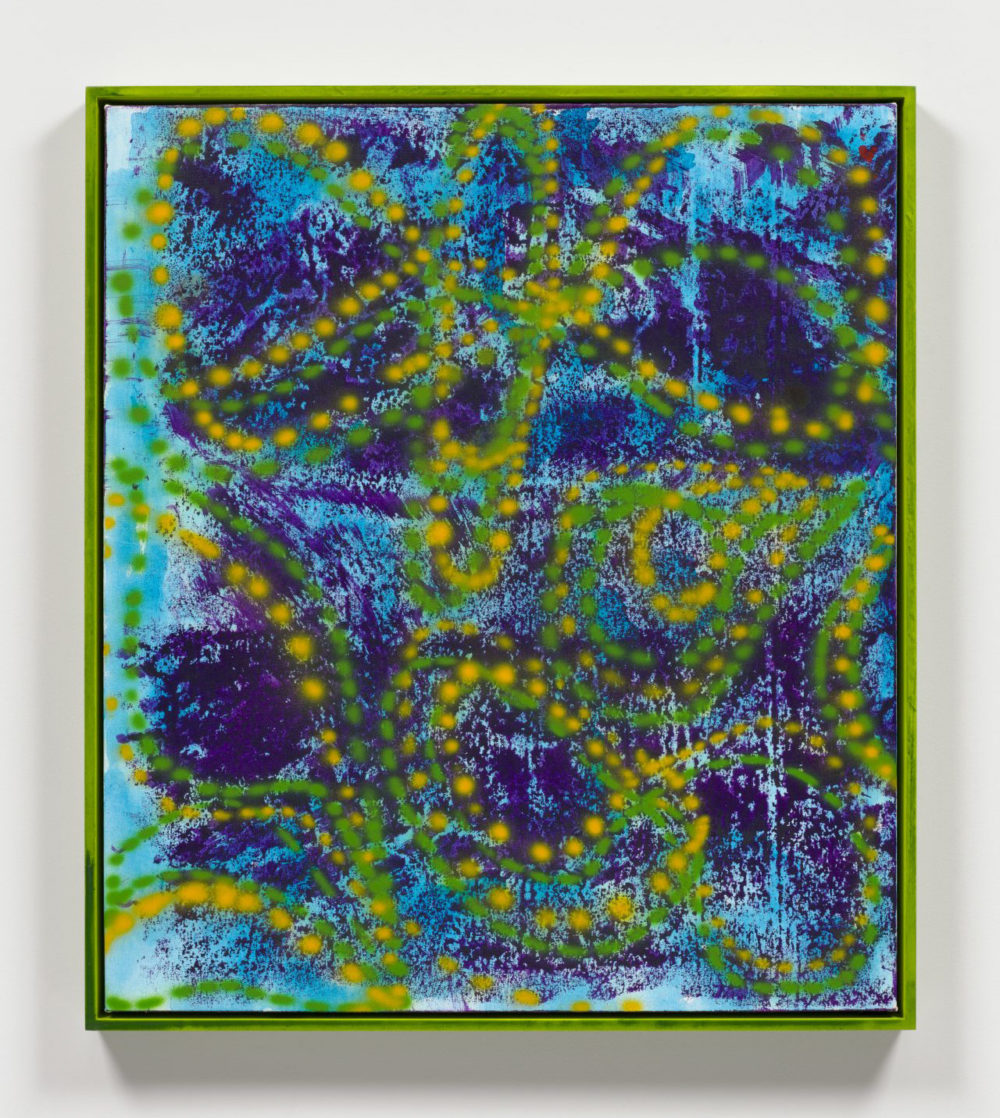
Keltie Ferris, Butterfly Paths (2021). Courtesy of the artist and Morán Morán.
KF: I like how that enables you to jump mediums or forms—from wall-based work to painting to more sculptural pieces, even to architecture and to writing. It all seems to knit itself together. It spawns from the head of Zeus and thus can take forms in many kinds of materialities, which gives you a sense of freedom that I’m jealous of. That’s one thing I’ve been thinking about a lot, looking over your work—like your last show at Greene Naftali [“Heterotopia II” in 2019]. You’re embracing the whole space, manipulating it, and the painting is integral to that.
PH: And you did the same in your last show [“FEEEEELING” at Mitchell-Innes & Nash this year]. I’ve always been interested in site-specific paintings—altarpieces, paintings at the end of a church or in the chapels to the side. I think about how you walk through a three-dimensional space and encounter a two-dimensional image. Most of my installations are based on that, the idea of an image that you encounter in a specific spatial setting.
KF: It’s interesting because that kind of ties you back to the body, you know? Because the painting is an object in a space. But in that case, it’s maybe more about the viewer’s body rather than your body, which is kind of cool. It’s like you’re handing over the body to them. [Laughs]
PH: It’s contradictory to how I want to make the work and how I want it to feel. In my work, the measurements have to do with human scale, which I grew up with through Abstract Expressionism. I think that was the first real human-scaled painting.
KF: Have you never made a larger painting, something, say, mural-sized?
PH: I did once, a 40-foot-painting in the Dallas-Fort Worth airport, but what I found is that the components all have to have a human dimension, like something you can fit between your hands. Actually, that work was eight paintings put together in a grid. I just couldn’t just do one big image like that.
Your work isn’t exactly gestural, but it is painterly. What other painters do you admire? I’ve been looking at Joan Mitchell lately and those paintings drive me crazy. They’re so tortured.

Peter Halley, Too Late (2021). Courtesy of the artist.
KF: That’s so true. I think a lot about Joe Bradley, too. To me, he’s very indebted to Joan Mitchell, and no one ever talks about it. I was thinking about Joe Bradley and his robots in relation to your building paintings. Katharina Grosse—I’m intrigued by the scale and sense of diversity in her work. I feel like I’m always stuck at a certain scale.
The thing is, I think a lot about painters that are really different from me. I love Malcolm Morley, for example—his ability to paint whatever he wanted to paint and to move from subject to subject.
PH: When you mentioned Katharina Grosse, that made a lot of sense to me. The way I see it, gesture for you is lyrical; it’s rhythmic. Her work also has that kind of lyricism or harmony.
KF: What about you? What painters are you thinking about?
PH: I just got through reading Ninth Street Women and a book on Helen Frankenthaler. I’m sort of enmeshed in second-generation Abstract Expressionism right now. It’s really interesting to look at gestural paintings in the 1940s and ’50s. They really were committed to the idea that putting paint on the canvas with a brush was like a record of their existential state. It’s quite fascinating.
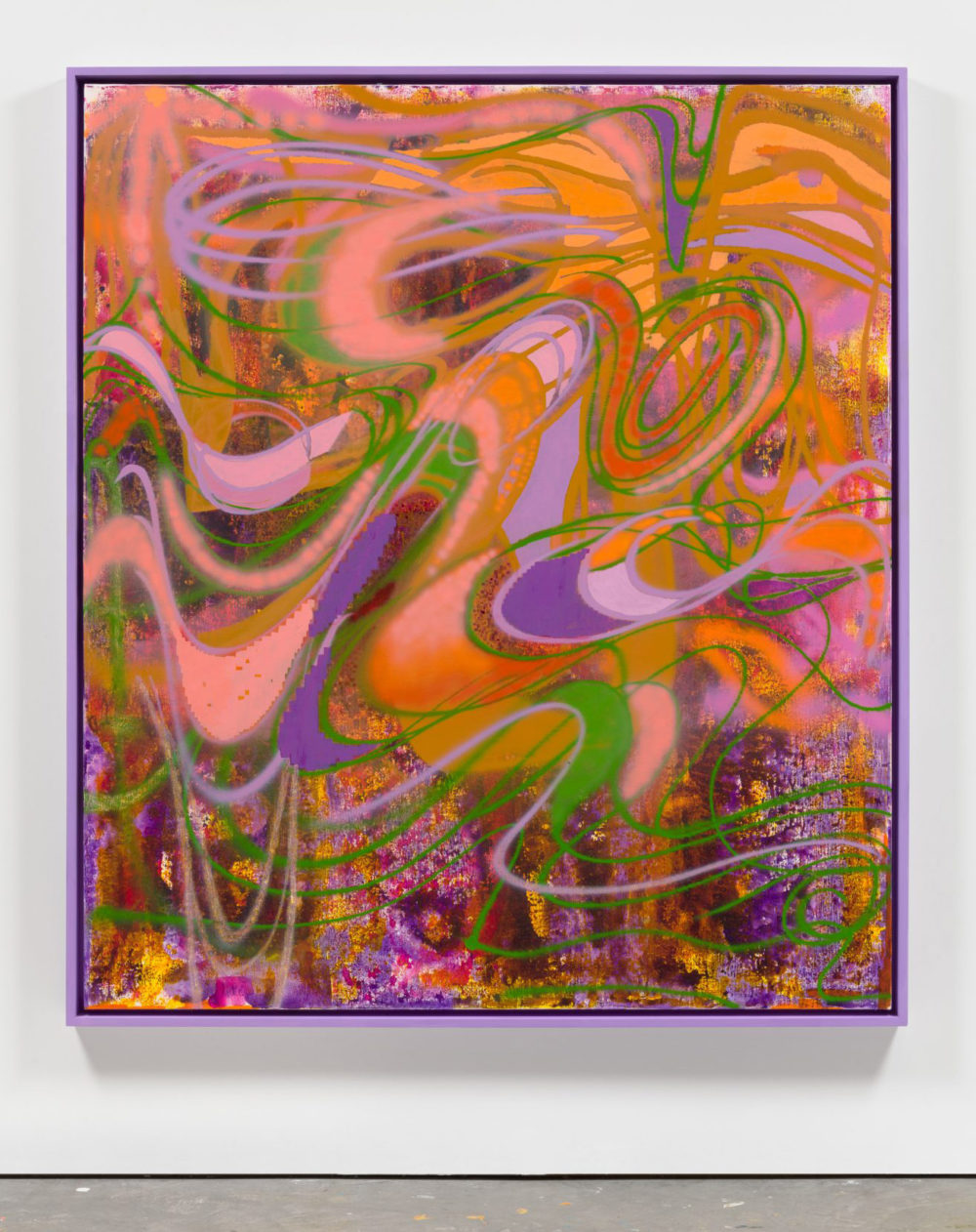
Keltie Ferris, Golden Rod (2021). Courtesy of the artist and Morán Morán.
KF: It’s interesting that you are in that time period. These classics, as much as you may want to get away from them, they never go away. At least that’s how I feel. Is that how you feel about it, or do you go back there as a kind of happy place? Do you think about making work in conversation with the current moment or what’s come before you?
PH: Starting around 1981, when I began to work with prisons and cells connected by conduits, I was convinced that that was a paradigmatic base of contemporary life. At the time I was thinking about cable TV and electric systems and so forth, but it pretty much ended up being a roadmap for digital connectivity. I was consciously trying to map the space that contemporary life was turning into. The ideas behind that have to do with physical isolation and a technological connectivity.
KF: And you did it! Talk about seeing the future. [Laughs]
PH: People gave me a hard time back then; they thought I was exaggerating. It turns out I underestimated it all. [Laughs]
I’m still living in that basic diagrammatic space. The work veers toward that or away from that in different ways, but that’s still the spatial world that I’m inhabiting. You can’t help but to describe the world that you’re coming into as a 30-year-old painter.
KF: Newness is definitely important to me. I think a lot about the timeless quality of painting. Both of us are interested in constructing paintings out of smaller bits or smaller marks. I’ve always been interested in Seurat and the Pointillists, how they built images out of dots. To me, that was an early scientific approach to painting that was a precursor to how we make images now.

Keltie Ferris, Untitled (2021). Courtesy of the artist and Morán Morán.
PH: I want to talk about color a little bit. When I used to teach all these talented people at Yale, I came to the conclusion that about nine out of every 10 artists are black-and-white oriented—they see in terms of chiaroscuro, light and dark, modeling. It’s really the exception that somebody thinks in terms of hue primarily. I think you probably do. Color and hue seem like they’ve always been primary components of your work. Has that been the case for forever?
KF: Yeah. I think it is a forever thing for me. I try to make work occasionally that’s black and white and it’s hard for me. In some ways it’s also simpler, because you’re taking out a whole layer of thought process. But, for me, it’s hard to find the heart of things without color. I think of colors in terms of the stories they tell and their connections to my own past experiences. I have many threads of color that I’m working on. There are color relationships that I ruminate on for years, on and off. Do you do that? Are there relationships between colors that you examine over time?
PH: Definitely. I’m looking at one of the paintings that I’m showing at the Independent. It’s all secondary colors—orange, green, purple. The secondary colors are always much more central to me than the primaries.
KF: Purple and orange—that’s a team or a friendship that I’ve been interested in for a long time. I like the awkwardness of it. Those colors make this outcast combination, even though they’re beautiful in their opposition. I’m also interested in other color relationships for the opposite reason. I’ve done a lot of red-and-blue paintings because of the centrality of those colors in our culture, from sports teams to flags to Pepsi advertising. I enjoy taking that centrality on.
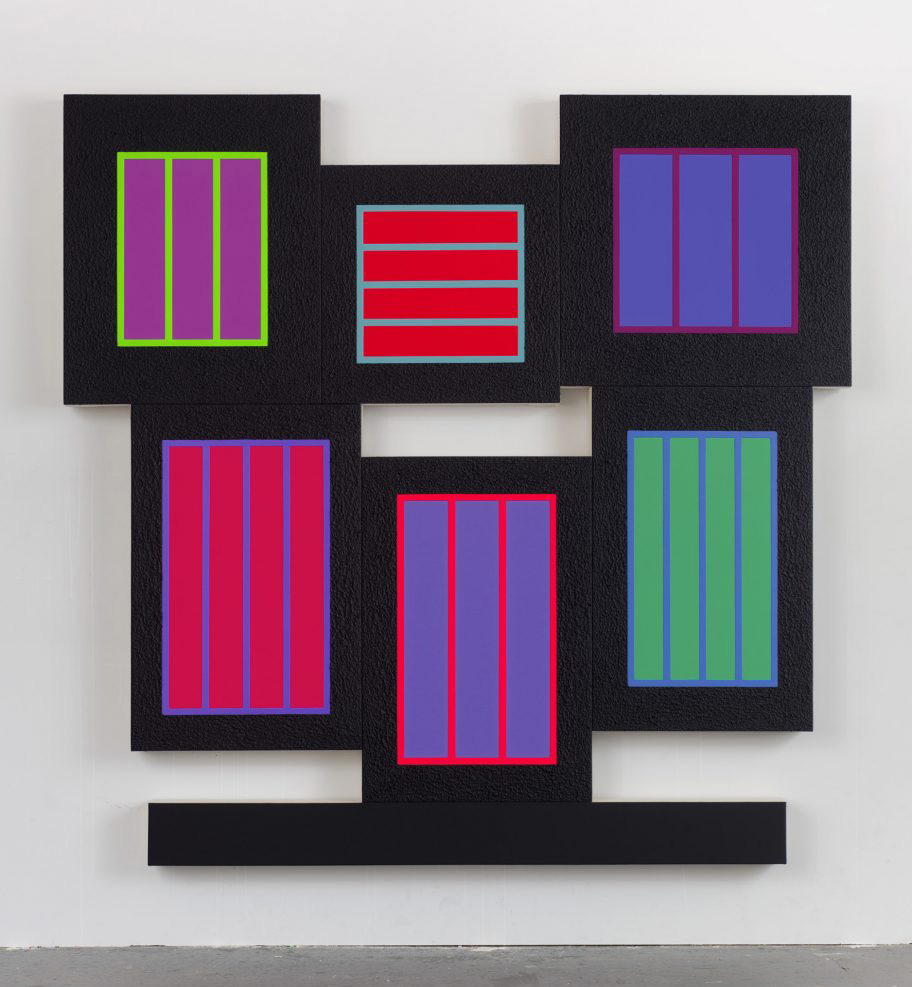
Peter Halley, How it Ends (2021). Courtesy of the artist.
PH: I think the way a painter chooses color as being akin to the way a composer chooses to work in a certain key.
KF: Yeah, color provides a harmonic key; you can work inside and outside of the rules that it sets up. I like to find the chords and discords and walk in and out of that sense of congruency as I work.
You have a thing for yellow, don’t you?
PH:: I like yellow. I like red. [Both laugh]
KF: But it’s more complicated than that!
PH: Not really. [Laughs]
KF: I was making a lot of yellow paintings, but then people started talking about how happy they were and that seemed way too simplistic to me. So I stopped; I backed away from yellow.
PH: I did something kind of naughty for the Independent. I’ve made a painting with six blocks—three primaries and three secondaries. And then in the other painting, I cheated. I put black around everything. [Laughs]
KF: Why do you think that’s cheating?
PH: It makes everything glow. It’s easy.
KF: Yeah, black—when it’s used as a separator between colors—that’s cheating, in that every color is contained and separate. It minimizes the interactions; it minimizes a lot of the excitement and the discomfort people get from color, which I think often comes when two or more colors interact.
PH: Do you use black at all?
KF: Barely. For my last show three years ago [“(F(U(T( )U)R)E),” at Mitchell-Innes & Nash in 2018], I worked by making drawings and then filling them in with color. That was my attempt to take on black. That was me experimenting with being a different kind of artist, actually. My work at Independent is all about color, though.
KF: It’s very symphonic. I don’t know if you thought this was insulting, but when I wrote to you recently I said your new paintings look sort of Wagnerian. [Laughs]
KF: No, no, I thought it was dead on, in a way. I’ve been thinking a lot about sound and waves lately, how waves can take different forms.
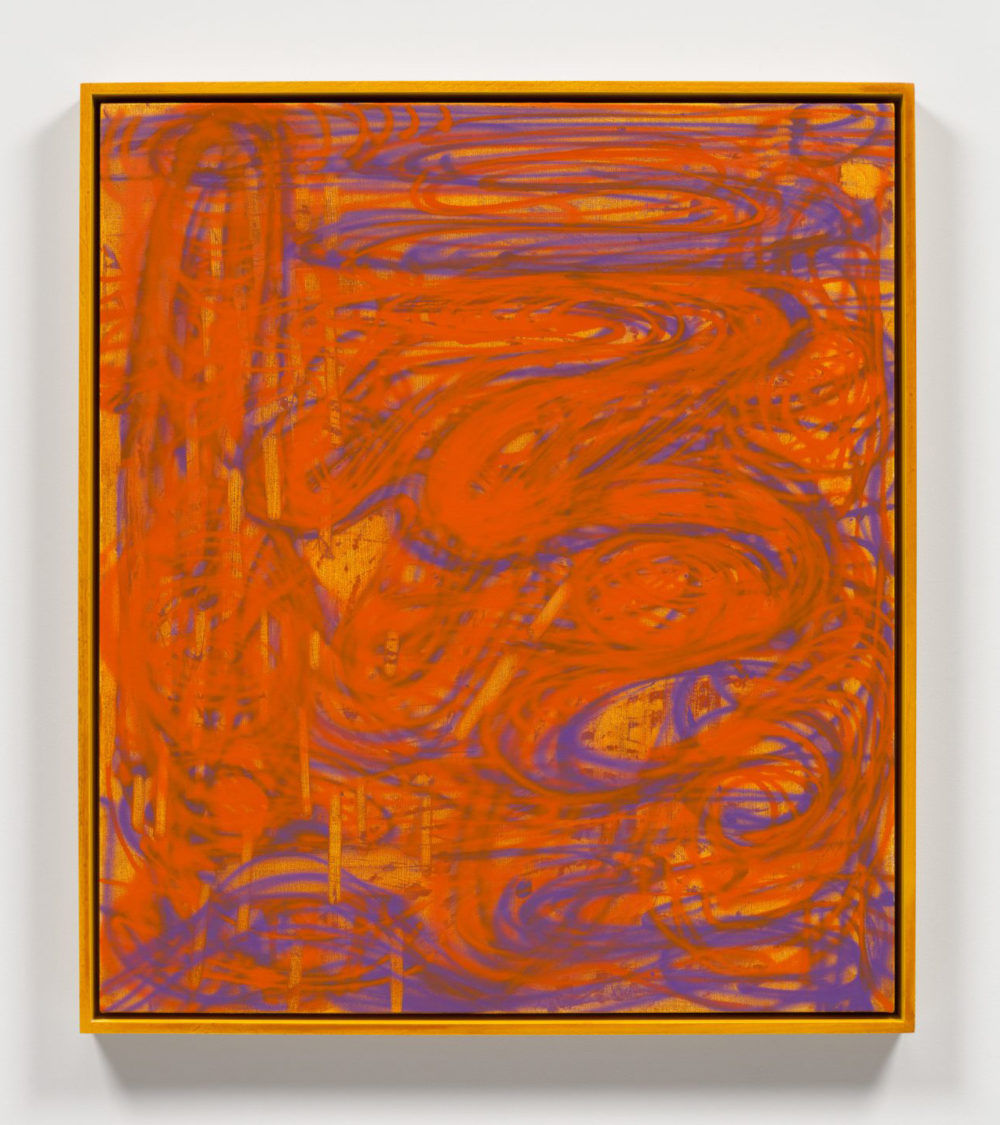
Keltie Ferris, Glow Down (2021). Courtesy of the artist and Morán Morán.
PH: I’ve never asked you how you make your paintings. I’ll start by talking about mine. Everything is a landscape space. There are these two icons—either a cell or a prison, and they’re connected in different ways. Unless the form is presented against the wall, it’s form-figure-ground or form with a clear background. I work out the drawing, then after that I start working with color. For each composition, I’ll often make five or six paintings with different color approaches.
I have no idea how you do it?
KF: I work in a variety of different ways, but I began most of the work that’s in Independent by blotting color on top of color, making these monoprints that I couldn’t control. There were these forms that began, just two colors interacting. Then I either kept doing that—like in the largest painting [Golden Rod], where there are many colors blotted on top of each other—or I would use that form as a ground to work with or against. In some, there are drawn elements that float over this ground and kind of ignore it or work with it to create something more cohesive.
PH: So you’re really using the materials almost in a spontaneous way to trigger your unconscious, and then you compose?
KF: Yeah. Lately, my work has all been about ceding my lack of control in the situation. This blotting mechanism of getting color down, it’s as anti-compositional as it gets, because I literally can’t see what I’m doing. And I’m often very frustrated by it. But I’ve been using that frustration and sense of powerlessness to generate the next steps. It’s something that I’ve always done—just put something down and create a problem to fix, then go forward from there. It doesn’t feel unconscious, I have to admit. It’s really slow, and I feel as though I’m making very conscious decisions. It’s just one step at a time, rather than thinking of it as a whole.
Independent runs September 10–12 (VIP preview September 9) at the Battery Maritime Building, 10 South Street, New York, New York.

